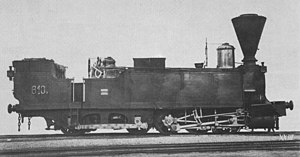SStB - Grünschacher to Sonnwendstein
| SStB - Grünschacher to Sonnwendstein / (SB 19 (old)) / (SB 33) / (BBÖ 371) | |
|---|---|
|
SB 610
|
|
| Numbering: | (SB 19 601–626) (SB 33 901–926) (BBÖ 371.01–10) |
| Number: | 26th |
| Manufacturer: | Cockerill / Seraing , Esslingen |
| Year of construction (s): | 1853-1854 |
| Retirement: | 1861–1864 conversion to Dn2 ( SB 19 ) |
| Axis formula : | C2'n2t |
| Gauge : | 1435 mm ( standard gauge ) |
| Service mass: | 56.1 t |
| Friction mass: | 36.0 t |
| Driving wheel diameter: | 1,068 mm |
| Number of cylinders: | 2 |
| Cylinder diameter: | 474 mm |
| Piston stroke: | 610 mm |
| Boiler overpressure: | 7.4 atm |
| Evaporation heating surface: | 136.0 m² (in contact with fire) |
The steam locomotives SStB - Grünschacher to Sonnwendstein were the first 26 support tender locomotives of the Southern State Railway (SStB) of Austria-Hungary of the Engerth type .
Since after the Semmering competition none of the four winning locomotives was up to practical use on the Semmering Railway, the advantages of the winning designs were combined under the direction of Wilhelm von Engerth to create a new mountain locomotive , the design of which was later named the Engerth locomotive . The new draft stipulated that part of the boiler weight should be taken over by the tender frame (supporting tender locomotive). In order to also use the adhesive weight of the tender, gear couplings were attached to four locomotives between the axles of the main frame and the tender. Since these and other similar devices did not prove themselves in operation, they were removed.
The first 26 locomotives were delivered by Cockerill in Seraing (16 pieces) and by the Esslingen machine factory (10 pieces). The first Cockerill engine delivered was named GRÜNSCHACHER , the first Kessler locomotive was called KAPELLEN .
All of the locomotives in this series came to the Südbahngesellschaft in 1858 as part of the privatization of Austrian state railways , which they referred to as the 19 series. All machines in this series were converted into normal quadruple coupled locomotives with standard tenders between 1861 and 1864 (for the relevant technical details see 19 ). The converted locomotives were in use until 1929.
literature
- Herbert Dietrich: The southern railway and its predecessors , Bohmann Verlag, Vienna, 1994, ISBN 3-7002-0871-5
- Hans Peter Pawlik, Josef Otto Slezak, Südbahn-Lokomotiven , Slezak publishing house, Vienna, 1987, ISBN 3-85416-102-6
